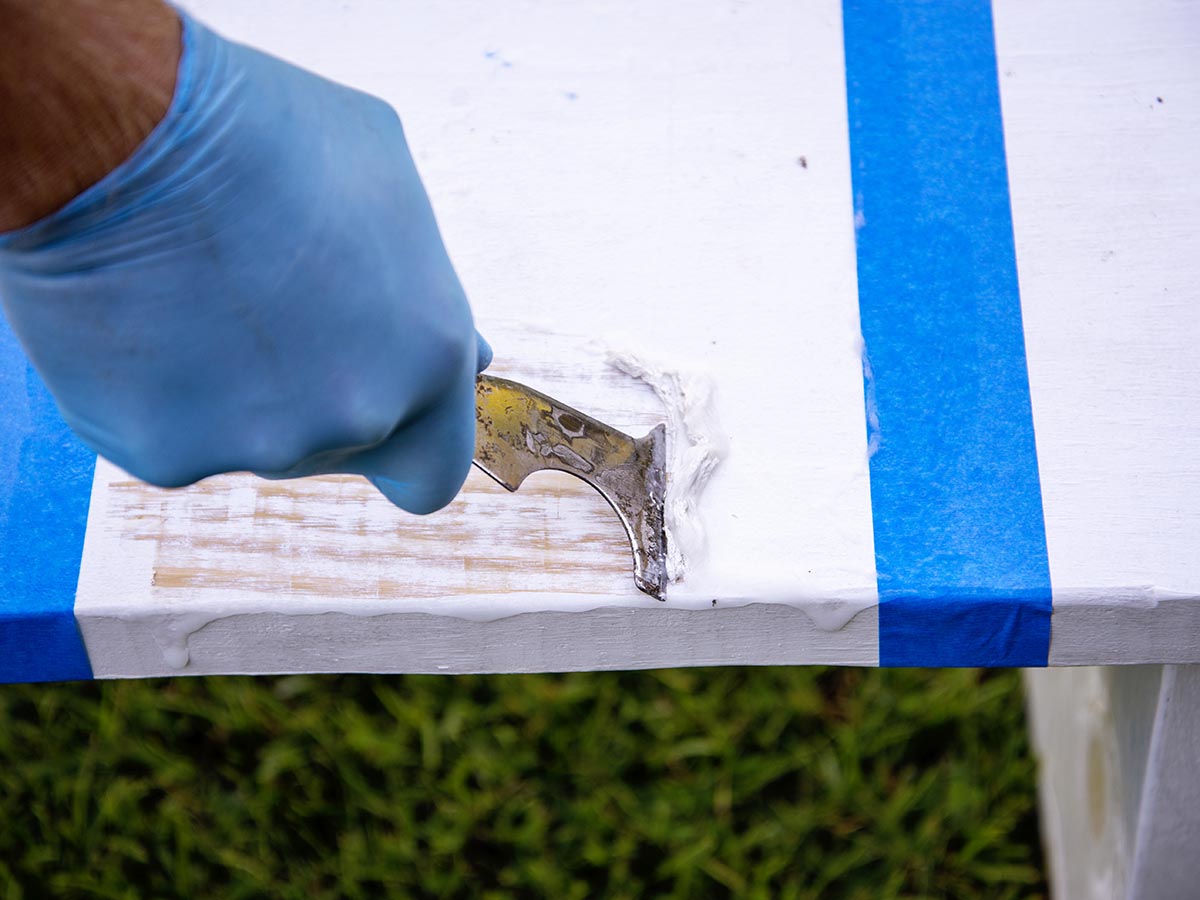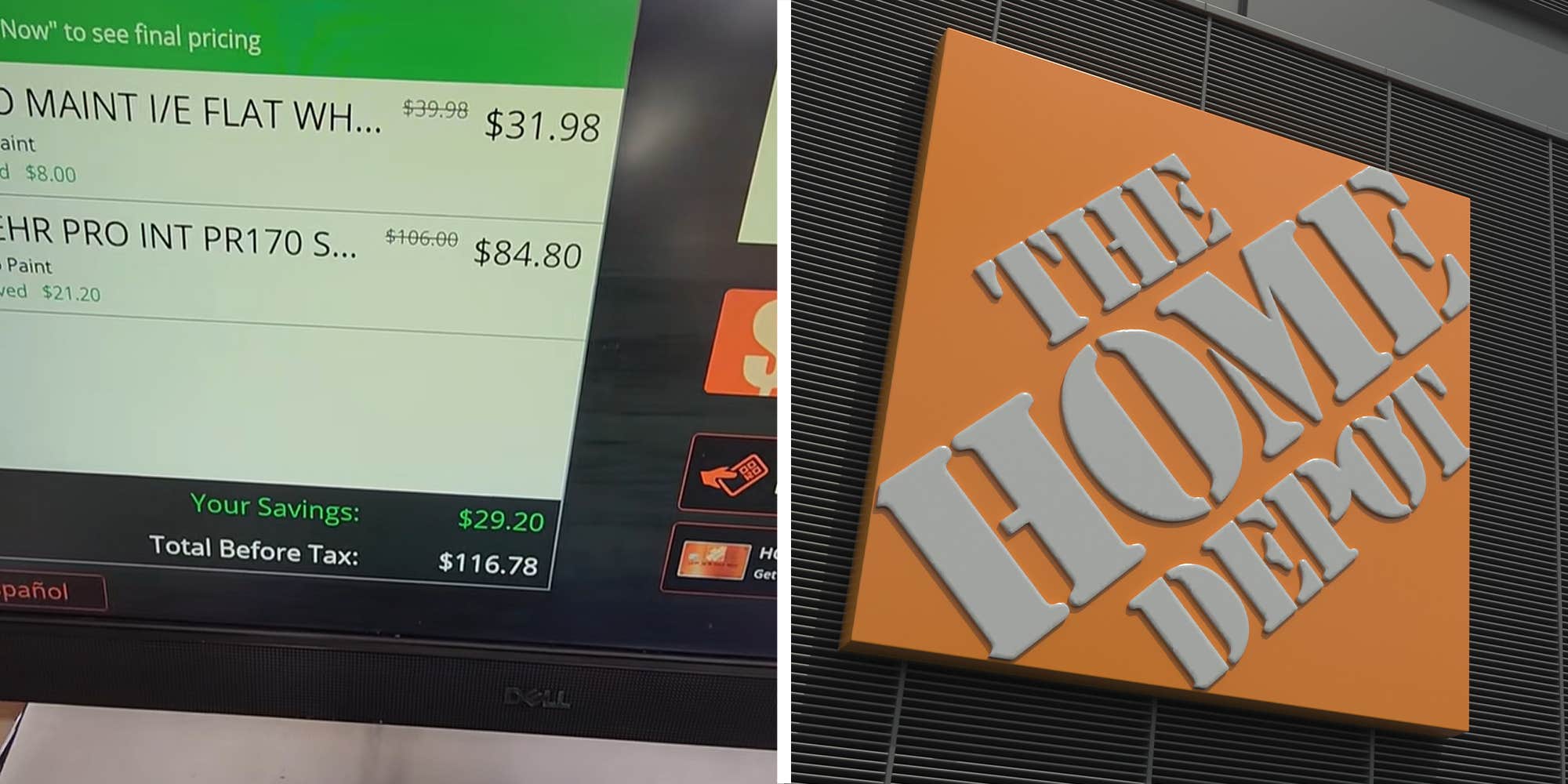We may earn revenue from the products available on this page and participate in affiliate programs. Learn More ›
Paint prep is a necessary but sometimes tedious step, and some types of paint prep are easier than others. On a piece of furniture with only a few isolated peeling patches, a little scraping and sanding may be adequate prior to priming and repainting. But for a project that has already been painted several times—and likely shows widespread chipping, cracking, or blistering—the existing finish must be removed completely before the project can be continued.
This can be done manually with a hand sander and a whole lot of elbow grease (not an option with lead-based paint) or with a paint stripper, which will take care of the task at hand in far less time and with far less effort.
Before setting out to purchase a paint stripper, know that not all are suitable for all types of paint and surfaces. Some include harsh chemicals that require special safety precautions. To help clear up any confusion and narrow the options, we shopped for, tested, and reviewed several paint strippers for a variety of uses. We found that the Dumond Smart Strip Advanced Paint Remover came out on top thanks to its low-odor formula that’s suitable for a wide range of surfaces. Keep reading to learn more about our shopping priorities, how these products performed in our tests, and why we consider them to be among the best paint strippers available.
- BEST OVERALL: Dumond Smart Strip Advanced Paint Remover
↓ Jump to Review - BEST BANG FOR THE BUCK: Max Strip Paint & Varnish Stripper
↓ Jump to Review - BEST ECO-FRIENDLY: Blue Bear 605Pro Multipurpose Coatings Remover
↓ Jump to Review - FASTEST-WORKING: Sunnyside Back to Nature Hi-Speed Ready Strip
↓ Jump to Review - BEST FOR WOOD: D Super Remover New Generation Stripper
↓ Jump to Review - BEST FOR METAL: Max Strip All-Purpose Remover
↓ Jump to Review - BEST FOR CONCRETE: Motsenbocker’s Lift Off Spray Paint Remover
↓ Jump to Review - ALSO CONSIDER: Citristrip Paint & Varnish Stripping Gel
↓ Jump to Review

Before Buying a Paint Stripper
Is it really necessary to use a liquid or gel paint stripper? It depends on the project. Paint stripper reaches into the crevices of ornate trim and molding to remove paint where scrapers and sandpaper struggle. Strippers also reduce or eliminate dust and debris caused by sanding and scraping. But for flat surfaces, skipping the stripper could be the best choice.
Professionals often remove old paint from surfaces like wood siding or furniture with just a paint scraper or coarse sandpaper. For tough, resistant finishes like varnish or layered paint, pretreating with a heat gun or steamer loosens the finish before scraping.
When window locks, door hinges, or hand tools are marred with paint, thrifty DIYers reclaim them with the help of a slow cooker. To do this, place the hardware in the pot, cover with water, add a few drops of liquid dish soap, and let it cook on high for 6 to 8 hours. Remove the hot items from the cooker with plastic tongs to avoid scratching them, and the old paint will peel right off.
How We Tested the Best Paint Strippers
In the process of sourcing and vetting paint strippers for this article, we reviewed more than 50 paint strippers. We had several priorities. The products we recommend do not include known carcinogens or present other potentially serious health risks when used as directed. Using them does not require an inordinate amount of investment in special applicators or safety gear. And they work when used according to the label directions.
To learn how each of these paint strippers perform, we spent 20 hours testing them on wood, metal, and concrete surfaces. We also used the heat-gun and paint-scraper method as a point of comparison. For the wood test, we taped off 12 feet of old window casing into equal segments, one for each of the strippers. For the concrete test, we marked out nine 12-inch squares on a basement floor. Likewise, we designated equal-size sections of corrugated-metal roofing sheets for the metal test.
Our window casing and basement floor had previously been painted. We spray-painted the roofing material and let it cure for a week prior to stripping. Following the directions on the label of each product, we applied the strippers, let the product work for the minimum recommended amount of time, then tested with a scraper at intervals until the paint was ready to remove. Then we used a paint scraper, paint-stripper pads, and stiff bristle brushes to remove the paint as if we were preparing the surface for a fresh paint job. If any of the products required additional time or another application to complete the job, we did so.
| Testing Stats | |
| Products tested | 8 |
| Time spent testing | 20 hours |
| Tests performed | 5 |
| Price range | $15 to $70 |
Our Top Picks
We researched and tested some of the best paint strippers on the market. The products below remove paint quickly and work on a variety of different coatings and materials. Read on to find out how they performed.
Best Overall
Dumond Smart Strip Advanced Paint Remover
Our Ratings: Application 5/5; Performance 4.5/5; Odor 5/5; Effectiveness 5/5; Value 5/5
Product Specs
- Type: Biochemical
- Volume: 1 gallon
- Surfaces: Wood, brick, metal, concrete, stone, tile, glass, and more
Pros
- Suitable for a wide range of surfaces
- Biodegradable formula is a more eco-friendly option
- No harsh odors; makes it easier to use indoors
Cons
- Does not cling well to vertical surfaces
The formula of this biodegradable paint stripper, which is free of methylene chloride and NMP, imparts no nasty fumes as it removes paint (including lead-based), varnish, and urethane from wood, metal, masonry, and other surfaces, indoors and out.
The biodegradable paint remover can be applied by brush, roller, or sprayer. It’s successful at stripping new and decades-old paint coats from stone, metal, and other painted surfaces, all with ease.
Dumond Smart Strip had the lowest odor of all the products we tested, which makes it a better choice for indoor projects. The thick consistency of the product made it easy to apply a ⅛-inch-thick coating, which scabbed over somewhat during the extended working time, but it didn’t dry out. The 4- to 24-hour working range meant it took a bit longer to loosen the paint thoroughly compared to some of the other products, but given adequate time it cleaned as well as any of the others. We awarded it best overall because of its low odor, eco-friendly ingredients, and effectiveness for a broad range of surfaces and coatings.
Get the Dumond paint stripper at Amazon or Ace Hardware (5-gallon size).
Best Bang for the Buck
Max Strip Paint & Varnish Stripper
Our Ratings: Application 5/5; Performance 3.5/5; Odor 4/5; Effectiveness 3.5/5; Value 4/5
Product Specs
- Type: Noncaustic and low-VOC
- Volume: 1 quart
- Surfaces: Brick, metal, porcelain, wood
Pros
- Drip-free gel formula allows for easier application
- Removes most paints and varnishes
- Simple cleanup with just water
Cons
- Slight unpleasant odor
- Tough jobs require additional treatments
- Thin consistency leads to it drying out quickly
Low-VOC water-soluble Max Strip paint and varnish stripper contains no methylene chloride or NMP. The no-drip gel formula sprays, brushes, or rolls on easily with less mess than regular liquid chemical paint stripper. It removes most types of paint and varnish from most porous and nonporous surfaces.
This Max Strip stripper costs less per ounce than any of the other products we tested. In our trials on wood, metal, and concrete surfaces, it worked effectively. However, applications went on lightly because of the relatively thin consistency, so we had to cover the work with plastic after each application to keep the stripper from drying out. Also, the thin application meant it was necessary to repeat the application a second time on some areas with multiple layers of paint, but those instances were minimal. For everyday use, this product could make a reliable cost-effective pick, but it may not be ideal for heavy-duty applications.
Get the Max Strip varnish and paint stripper at Amazon, Ace Hardware, Lowe’s, or The Home Depot.
Best Eco-Friendly
Blue Bear 605Pro Multipurpose Coatings Remover
Our Ratings: Application 5/5; Performance 4/5; Odor 3.5/5; Effectiveness 4/5; Value 5/5
Product Specs
- Type: Solvent
- Volume: 1 quart
- Surfaces: Concrete, masonry, metal, wood
Pros
- No methylene chloride or NMP; uses noncaustic and biodegradable ingredients
- Low odor; great for use indoors with little ventilation
- Can remove paint, varnish, enamel, and urethane
Cons
- May darken concrete; take care when using
- Contains a higher VOC (497 g/L)
- Not for use on PVC, drywall, limestone, plastic, veneer, terrazzo, or rubber
Those who thought that citrus-based products were the only green paint strippers will be pleasantly surprised with Blue Bear 605Pro. This powerful product is made from soy-based solvents and is 100 percent biodegradable. It applies easily with a built-in squirt applicator. The thick consistency makes it simple to spread with a squeegee, brush, or roller, and it adheres particularly well on vertical surfaces.
In our tests, Blue Bear 605Pro stripped paint especially well with a single application, including multilayered paint. The consistency was thick, which made it easy to apply a generous layer yet runny enough to penetrate wood-trim details and pitted concrete. The downside of the extra-thick consistency was that it gave the scraped paint a gooey texture, which was a bit more messy to clean than the thinner products. The odor was not exactly pleasant but also not overwhelming. We found it to be highly effective and eco-friendly.
Get the Blue Bear paint stripper at Amazon or Franmar.
Fastest-Working
Sunnyside Back to Nature Hi-Speed Ready Strip
Our Ratings: Application 5/5; Performance 4/5; Odor 3.5/5; Effectiveness 4/5; Value 5/5
Product Specs
- Type: Biochemical
- Volume: ½ gallon or 32 ounces
- Surfaces: Wood, plaster, metal, brick, masonry, concrete, marble, veneers
Pros
- No methylene chloride, so no harsh chemical odor
- Fast-acting formula is ideal for quick weekend projects
- Cleans up easily with just water
Cons
- Thin layers are less effective; may require several coats
This paint stripper starts working just 30 minutes after application, making it one of the fastest means of stripping paint from wood, plaster, concrete, brick, stone, and masonry. It removes up to three layers of water- or oil-based paint and varnish and is applied with a sprayer, brush, or roller.
In addition to being a fast-acting product, Sunnyside hi-speed ready strip also produces low VOCs and uses no methylene chloride or other harsh chemicals, making it environmentally safe and leaving only a pleasant citrus aroma. It’s available in ½-gallon containers, which is enough to cover about 20 square feet, and quart-size spray bottles.
The test projects we treated with Ready Strip were consistently ready for paint removal in less than an hour. It did a great job of lifting single coats of paint but typically left residue behind when it came to multilayered paint. After a second application and some work with a paint-removal pad, the residue came off easily enough. The texture was moderately thick, so vertical surfaces were no problem. The odor was moderate and not completely unpleasant. This could be another good option for indoor projects.
Get the Sunnyside paint stripper at Amazon, The Home Depot (32 ounces), Max Warehouse, or HardwareAndTools.com.
Best for Wood
D Super Remover New Generation Stripper
Our Ratings: Application 5/5; Performance 5/5; Odor 1/5; Effectiveness 5/5; Value 4/5
Product Specs
- Type: Solvent
- Volume: 1 quart
- Surfaces: Wood, metal, and concrete
Pros
- Eco-friendly formula uses no methylene chloride or NMP
- Works fast (in just 15 minutes)
- Removes paint, epoxies, shellacs, varnishes, and more
Cons
- May need to apply product more than once for it to work
- Each application requires a thick layer of product
- Strong odor; not great for use indoors
This paint stripper’s ability to remove some of the most commonly used coatings for wood, including oil- and water-based paint, epoxies, varnishes, shellacs, and lacquers, makes it an ideal paint stripper for wood. This formula does not include methylene chloride or NMP, which is safer for the user and the environment while also being gentler on wood. This makes it an ideal choice for stripping antique furniture. Be sure to use protective equipment for safe handling, including long sleeves, gloves, and goggles.
It begins stripping paint just 15 minutes after application and will remove up to five layers. Apply by pouring the stripper onto the surface and use a scraper to remove. D Super Remover stripper is available in 1-quart or 1-gallon cans.
For detailed woodwork, a chemical solvent like D Super Remover is sometimes best because it reaches deep into pattern work, quickly removes the finish, and won’t gum up the surface. It worked fast enough in our tests that the thin layer of solvent didn’t have a chance to dry out. We were able to scrape single-layer paint less than a ½ hour after application. With multilayer paint, it worked in just over 1 hour. The odor is intense, so make sure the work area has excellent ventilation before opening the can.
Get the D Super Remover paint stripper at Amazon.
Best for Metal
Max Strip All-Purpose Remover
Our Ratings: Application 5/5; Performance 4/5; Odor 2/5; Effectiveness 4/5; Value 4/5
Product Specs
- Type: Low VOC
- Volume: 22 ounces
- Surfaces: Flooring, granite, marble, concrete, wood, glass, metals, brick, ceramic, upholstery, and more
Pros
- Works on various surfaces, including carpet
- Easy-to-use spray bottle
- Cleans up with water
- Ideal for cleaning tough stains on cars
Cons
- Gel can make the sprayer difficult to use
- Limited spray bottle size is best for small projects
The spray-bottle packaging and fast-acting formula of this paint stripper from Max Strip make it a good paint stripper for metal. The stripper sprays on, making it ideal for removing paint from cars and other surfaces that may be scratched by using a brush or scraper. The stripper also works quickly—in about 15 minutes—and is in a gel form, making it ideal for clinging to slick metal surfaces.
Max Strip all purpose remover does not produce harsh fumes or odors and rinses away with water. In addition to paint, Max Strip also conveniently removes other materials that frequently end up on a car, including tree sap, sticker residue, and glues. It comes in 22-ounce bottles.
In our surface tests, Max Strip was easy to apply. It adhered well to vertical surfaces and penetrated textured surfaces. The consistency was fairly thick, but we had no trouble with it flowing through the trigger sprayer. The product emitted a slightly unpleasant odor, but it wasn’t overpowering. Working time varied from approximately a half hour for a single paint layer to about 3 hours (wrapped in plastic to avoid evaporation) for multilayer removal. The trigger spray and smaller package make this a good choice for small projects or household cleanup tasks.
Get the Max Strip all-purpose paint stripper at Amazon, Lowe’s, The Home Depot, or Walmart.
Best for Concrete
Motsenbocker’s Lift Off Spray Paint Remover
Our Ratings: Application 5/5; Performance 4/5; Odor 4/5; Effectiveness 4/5; Value 4/5
Product Specs
- Type: Low-VOC biodegradable
- Volume: 22 ounces
- Surfaces: Vehicles, street signs, buildings, walls, floors, fiberglass, metal, tile, vinyl, plastic, brick, and concrete
Pros
- Water-based biodegradable formula
- Specialized for graffiti removal; works on multiple surfaces
- Made in the United States
Cons
- Less effective on enamel paints
Removing paint that’s soaked into the porous surface of masonry can be a challenge. This paint remover works to break the molecular bonds in paint, making it capable of lifting spray paint, aerosol paint, enamel, and other paint types from porous concrete.
Unlike other strippers that liquify paint, this formula breaks it into small solid pieces that can be rinsed out of porous materials. In addition to concrete, it also works on stucco, fiberglass, brick, metal, and vinyl. It produces low VOCs and uses no harsh chemicals. Motsenbocker’s comes in a 22-ounce spray bottle.
The ready-to-spray bottle and eco-friendly formula make Lift Off an easy choice for cleaning up outdoor spaces like spills or graffiti on sidewalks, driveways, and retaining walls. We found it easy enough to apply a thick, even coating, which stuck well on vertical surfaces. It cleaned up our basement floor test area with two applications and 3-minute working times and only produced a slight odor. We did not test outdoors in direct sunlight, which may require covering treated areas to prevent the product from drying.
Get the Motsenbocker’s paint stripper at Amazon, Ace Hardware, or Walmart.
Also Consider
Citristrip Paint & Varnish Stripping Gel
Our Ratings: Application 5/5; Performance 4/5; Odor 5/5; Effectiveness 4/5; Value 5/5
Product Specs
- Type: Biodegradable
- Volume: 1 quart
- Surfaces: Wood, metal, masonry
Pros
- No harsh odor; great for indoor projects
- Can stay active for up to 24 hours
- Comes in an easy-to-pour container
Cons
- Can take a while to remove several layers
Formulated with citrus terpene and NMP, this indoor-outdoor paint and varnish stripper with a citrus scent earns high praise from DIYers who return to the product again and again for a countless variety of repair and improvement projects. The stripper goes on with a gel-like consistency and works to loosen multiple layers of water- or oil-based paint, varnish, shellac, or epoxy from wood, metal, or masonry in less than a half hour—without corroding the painting surface.
Citristrip worked well in all three of our tests on wood, metal, and concrete. The gel formula was easy to apply with a paint brush and stuck well to vertical surfaces. It was a bit thicker in viscosity than most of the others, which helped to prevent drying, but it made the cleanup a bit messier. Wait time was similar to the other eco-friendly products, at about 1½ hours for a single layer of paint, and 2½ hours for multiple layers. The orange-ish odor was pleasant, and it’s another good choice for interior work. Note that it works best when given an extended working time.
Get the Citristrip paint stripper at Amazon, Lowe’s, The Home Depot, or Rockler.
What to Consider When Choosing a Paint Stripper
When looking for a paint stripper, it’s crucial for shoppers to consider a few factors, including the type of paint stripper, the materials that it works with, and how safe it is to use. Just ahead is more information about these factors and other important characteristics of paint strippers.
Type
There are four main types of paint strippers that function in unique ways and contain varying levels of VOC content.
- Solvent: The most versatile paint strippers, solvent products rely on toxic chemicals to loosen the bond between paint and surface. While some have methylene chloride, which has a high VOC content, others include a combination of alcohol, toluene, and methanol. High-VOC products generally have smellier fumes and are more of a health hazard than other strippers.
- Caustic: These strippers, with an active ingredient of lye (i.e., sodium hydroxide), partially convert dried paint into soap, causing it to loosen from the surface. Since caustic strippers are alkaline (high pH), the stripped surface must be neutralized (returned to a pH of 7) by wiping it down with a water-and-vinegar solution.
- Biochemical: These safer alternatives to solvent and caustic strippers are usually made with a combination of a plant-based solvent such as terpene and the organic compound N-methyl-2-pyrrolidone (NMP). Though lower in VOCs and fumes, NMP can still irritate the skin and adversely affect the respiratory and reproductive systems.
- Zero-VOC: Shoppers who are concerned about using the strippers listed above might want to consider VOC-free paint removers made without methylene chloride, lye, or NMP. These virtually odorless, though pricier, products are made with naturally occurring solvents like benzyl alcohol.
VOCs
Like the paint, varnishes, and lacquers they remove, paint strippers can put off volatile organic compounds (VOCs) that can be harmful to breathe in and cause nose, throat, and eye irritation. While VOCs are less of a concern when working outdoors, they can be harmful when working indoors, especially if there is limited ventilation.
Strippers with high VOCs typically use harsh chemicals in their formulas. Shoppers who are planning to work indoors will want to look for a paint stripper that does not use chemicals (such as methylene chloride) that produce high VOCs.
Surface Material
Different types of paint strippers perform better on certain surfaces. Shoppers will want to choose the paint stripper that’s best suited for the intended surface application:
- Solvent: These paint removers effectively strip paint as well as epoxy and polyurethane from wood, masonry, and metal surfaces without discoloration.
- Caustic: This type of paint stripper is ineffective on epoxy and polyurethane; caustic strippers are best for removing oil-based paint on masonry surfaces, such as concrete floors and brick fireplace surrounds. While they remove water- and oil-based paint from some metals and wood, caustic strippers can erode the likes of aluminum and blacken hardwoods such as maple (this darkness can be removed with wood bleach).
- Biochemical: These paint removers are ineffective when applied to epoxy and polyurethane but can remove water- or oil-based paint from masonry, metal, and wood.
- Zero-VOC: These paint strippers can break down the resins of water- and oil-based paint to loosen it from metal, masonry, and, to an extent, wood. They’re less effective at removing epoxy and polyurethane.
Safety
While some paint strippers are less hazardous than others, all types must be applied while using protective equipment. Be sure to use the following protective gear when handling whichever type is chosen:
- Solvent: Directly inhaling the fumes of solvent strippers can damage the brain or reproductive system, so always wear a respirator in addition to safety glasses, skin-covering clothing, and gloves made of a chemical-resistant material like butyl.
- Caustic: These strippers can irritate the eyes, skin, and lungs if touched or inhaled. However, they’re considered safer and lower in VOCs than solvent strippers. A respirator, safety glasses, skin-covering clothing, and chemical-resistant gloves are still recommended when working with them.
- Biochemical: This type of paint stripper is safer than caustic products. However, a respirator, chemical-resistant gloves, and skin-covering clothing should still be worn when handling these products.
- Low-VOC: While low-VOC paint strippers are the safest type available, direct exposure can still irritate the lungs or redden the skin, so a respirator and safety gloves are recommended.
Shoppers who are stripping old paint in homes built pre-1978 will want to first test with a lead paint test kit. If the test is positive, it’s important to choose a paint stripper labeled for use on lead paint (these strippers may fall into any of the four categories of paint strippers above and usually come in a paste or gel form to trap lead particles and keep them from going airborne).
Application
When applying paint stripper, users will need to dip a disposable paint brush into the product to apply it in the thickness recommended on the package instructions. The brush is moved in short strokes in a single direction (on wood, it’s moved in the direction of the grain). If the product comes with laminate paper squares for easier paint removal, the squares are adhered to the wet stripper immediately after application.
- Solvent: These strippers need only be applied in a thin layer (usually less than ⅛ inch) and stay on the surface briefly (often less than 15 minutes) before paint can be easily lifted off with a paint scraper. The stripped surface must then be washed with water or mineral spirits before repainting, but it won’t require a neutralizing agent.
- Caustic: Caustic strippers must be applied in a ⅛-inch to ¼-inch layer and require a dwell time of at least 30 minutes before paint can be scraped off.
- Biochemical: These must be applied in a thick ⅛-inch to ¼-inch layer and be left on the surface between 3 and 4 hours before paint can be removed with a scraper. While the stripped surface must be washed with water or mineral spirits, there’s no need to neutralize.
- Low-VOC: These usually require an application of ⅛ inch to ¼ inch and dwell time of 3 to 24 hours before paint can be removed. Users will need to follow up with a rinse of water or mineral spirits (no neutralization needed).
If the paint stripper requires a neutralizing step, it’s important to use the solution recommended on the package (or a solution of equal parts vinegar and water), then test the pH of the stripped surface with pH paper to ensure it has a pH of 7. For paint strippers that don’t require neutralizing, users will need to wash the stripped surface with the cleaner recommended on the packaging (usually plain water or mineral spirits).
Tips for Working With Paint Remover
In addition to application tips for the different types listed above, users will want to follow these practices for safe and effective use of any paint stripper:
- Strip paint outdoors whenever possible to maximize ventilation. If any individual parts of furniture can be removed, e.g., cabinet doors, take these parts outdoors to strip paint or varnish. If the paint stripper must be applied indoors, users should place a fan behind them as they work and open a window on two opposite sides of the room for ventilation.
- Lay a chemical-resistant tarp over the floor and any furniture that can’t be moved out of the room.
- Let the paint stripper stay on the surface for the recommended dwell time on the package instructions.
- Use a paint scraper or a drywall knife whose edge has been slightly dulled with a metal file to lift off the loosened paint (and any laminate paper squares) in a continuous motion and in a single direction (in the direction of the grain if stripping wood). Sweep the paint waste into a resealable plastic bag with the scraper.
- If any paint remains trapped in the grooves of porous surfaces such as wood or masonry, gently scrub the surface with a plastic mesh scouring brush (or, if outdoors, rinse the surface with a power washer) to remove.
- Let the surface dry completely; turn on portable fans in the room to speed up drying.
- Discard the bag of paint waste at a local hazardous waste disposal site, which can be found by entering ZIP code or address in the Resource Conservation and Recovery Act Information (RCRAInfo) search tool.
FAQs
If you have questions about how to use paint stripper or dispose of it when you’re done, then read on for answers to these and other commonly asked questions about these products.
Paint stripper will not ruin clothes. In fact, some paint strippers can be used to remove paint from clothing.
While paint stripper does not have an expiration date, it’s a good idea to keep it tightly sealed when not in use to prevent contaminants from getting into the container. Store it in a dry location protected from extreme temperatures.
The Sunnyside paint stripper is one of the fastest-acting paint strippers on the market, removing paint in as little as 30 minutes.
Don’t throw paint stripper in your trash can. Follow disposal instructions on product labels and the guidance of your local waste hauler or municipality. Due to the chemicals used in paint strippers, most municipalities require paint strippers to be disposed of at a hazardous collection facility.
Meet the Tester
Mark Wolfe is a writer with an extensive background in the green industry and an avid DIYer who lives in a 50-year-old home. When he isn’t writing, he spends his time upgrading, repairing, and replacing anything and everything in his home, yard, and garden. He tests and writes reviews about hand tools, lawn care and home repair products, and outdoor-living goods.










